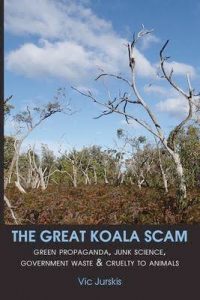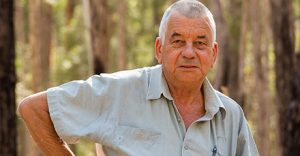Good news doesn’t boost TV ratings, sell newspapers or aid fundraising campaigns, but there is a huge industry based on seemingly concocted environmental crises. Multinational green ‘charities’ such as World Wildlife Fund might collapse if the simple truth got out. That’s why I want to tell you about koalas. Source: Vic Jurskis, photo courtesy Ben Marden
I didn’t think I’d need to write a book because I naively trusted in scientific debate. My Ecological History of the Koala was accepted for publication in CSIRO’s Wildlife Research journal.
That should have been enough to start a debate, particularly after it was publicised in The Australian and I was interviewed by Fran Kelly on ABC Radio National. There was a brief flurry of debate involving some scientists, but no scientific debate.
For example, Professor Frank Carrick AM apparently lodged an official protest with ABC RN’s executive producer. Carrick is the Koala Study Program Chief Investigator at The University of Queensland.
He said that he was outraged by the misrepresentation of the status of koalas, and that “there is substantial consensus amongst Ecologists with significant knowledge as to the dire severity and underlying causes” [of recent population crashes].
Carrick went on: “I don’t believe it [my paper] really contains a basis for the more egregious sweeping generalisations promulgated in the interview”. (I looked in a dictionary and found that egregious means outstandingly bad. I’m not sure what the great koala scam more egregious means.)
According to Mr Carrick “the challenge to conventional wisdom is not based on objective reality!” and “is just ludicrous – at least 80% of Koala habitat in existence at the time of European occupation has been destroyed”.
In 1988, Professor Carrick produced a map showing the “approximate likely distribution of koalas 200 years ago” a time when Europeans didn’t know they existed. Carrick had them right across most of eastern Australia.
By contrast, award winning historian Bill Gammage said: “their locations were distinct, lightly populated and few”. Professor Carrick recently told a Senate Inquiry into Australia’s Extinction Crisis, koalas were so scarce 40 years ago, when he started studying them at University of NSW, that he had to use “surplus” koalas from Victoria “and the decline has accelerated in the last decade”. I guess he may have some sort of mental block about the irruptions that occurred in-between.
The good professor dismissed my allegedly “eccentric view” as “completely fallacious denial” and stated that “RN Breakfast has … orchestrated music to the ears of vested interests who wish to continue the unfettered, ongoing destruction of Australia’s residual forests and woodlands”.
I guarantee you that I have no vested interest, only a passionate desire to reinstate the beautiful, healthy, safe and diverse landscape that I was privileged to experience in my youth. Unlike RN Breakfast, The Australian responded to the professor’s outrage with two follow-up articles.
Carrick likened my paper to “climate-change denial” and rejected it as a “significant departure from reality”. Environment Editor Graham Lloyd produced a colourful article covering the best part of a page – KOALAS IN FREE FALL. He pronounced that “historical records disagree” with me, because millions of koalas were killed “at the beginning of the 20th century”.
Lloyd seems happy to deny the documented scarcity of koalas during the first 100 years of European occupation. He described me as a sceptic [ie a scientist] and quoted me eight times, but hasn’t spoken with me or responded to my communications.
Lloyd’s story featured a half-page photo of a female koala and her joey, seemingly posed on top of a windrow of dead trees. She didn’t look very comfortable sitting with her bum on a log and hanging on to a branch stub with her hands and the first toe of each foot (the one with no claw). Nor did the joey look happy, or even natural, sitting and reaching out for mum’s arm.
Dead trees had been pushed and stacked, but the caption described this apparent clearing operation as “logging … near Kin Kin”. Scientists from Australian Koala Foundation, National Parks Association, World Wildlife Fund etc, were quoted to back up the story. I’ve ‘agreed them to death’ about the recent population crashes and explained that they’re inevitable consequences of irruptions.
Lloyd also referred to Sue Arnold from Australians for Animals who managed to convince US authorities to list koalas under their Endangered Species Act. Arnold said estimates of koala numbers are “highly questionable”. I fully agree with her. It doesn’t matter, because koalas were naturally very scarce. Arnold had stated on her Koala Crisis Facebook site:
After the headline in the Australian on Saturday – ‘The Great Koala Scam’: falling numbers not a crisis, says expert – quoting well known anti environmentalist fanatic, Vic Jurskis, was followed up on Monday with ABC’s Fran Kelly interviewing this horrible excuse for an ecologist. Sic … This same nasty biased man writes that Queensland State Environment Minister Steven Miles plan (last year) to set up a “brains trust” on koalas “is a plan to ban dogs from a couple of suburbs where they are currently feeding on starving, diseased koalas living in declining backyard trees”.
Arnold reckoned that I “raved on” and that my “ignorance” was worthy of an Olympic Gold Medal. Also: “Jurskis is a forester who hates conservationists”. However, her comments were quite moderate compared to some feedback I received via ‘social’ media from a Wildlife Carer: “If your (sic) the same Vic Jurskis as in the Australian paper. Then you pal are a complete fxxwit with your head jammed up your arse. If it’s not the same block then I apologize.”
Anyway, I was pleased to have received some publicity and anticipated that the great koala scam some scientific debate would ensue. Unfortunately, this was not to be the case. You’d think that Professor Carrick and his like-minded colleagues would jump at the opportunity to submit a response to my “ideology” in Wildlife Research, and ‘set the record straight’. But that’s not how ‘scientific consensus’ works.
The groupthink exponents push their emotional arguments in the popular media and often put their names jointly, as an implied majority of scientists, on letters to politicians. They avoid scientific debate by ignoring any articles that sneak through challenging the conventional wisdom.
Such rare articles are swamped by the sheer volume of contributions from groupthinkers. In my case, the process was seemingly facilitated by Wildlife Research journal. After my Ecological History was submitted, thoroughly refereed and accepted as a Review, the journal’s website announced its imminent publication. Before it was published, the editors advised me they did not welcome my acknowledgement that they had motivated me to produce a review. They decided to rebadge it as a Viewpoint, implying a much lesser standard of scientific rigour, even though my 13-page article far exceeded the Journal’s limit of four pages for viewpoints, otherwise called “opinion papers”.
In the two years since my review was published there has been no comment or reference to it in the scientific literature. Compare that to nine citations over a similar period of my less controversial paper about forest health in Forest Ecology and Management. This review also referred to irruptions of koalas in declining forests and has now been cited at least 168 times in the international scientific literature, but never in relation to koalas.
San Diego Zoo has the biggest population of koalas outside Australia, with 20 on-site and 30 on loan elsewhere. They had a Fact Sheet which stated: “Beginning of European settlement: An estimated 10 million koalas existed around 1800 in Australia”. I advised them the Fact Sheet was incorrect and gave them a copy of my peer-reviewed Ecological history of the koala. They changed the text to “Early European settlement …” and took advice from experts that there is debate about the abundance of koalas when whitefellas arrived. They said it would be helpful if I were able to “cite peer-reviewed sources”.
After I sent them another peer-reviewed source, they removed any reference to the first century of European history in Australia:
Estimated that 10 million koalas existed in Australia when koala fur trade began in the late 1800s (Australia Koala Foundation, personal communication, 2018; also see AKF publication)
Their Fact Sheet still stated incorrectly that “80% of koala habitat has been destroyed due to development, drought, and fires”. The AKF publication cited in the Fact Sheet stated that “very little is known about the history and distribution of the koala prior to the fur trade”. It seemingly dismissed Harry Parris’ historical account of a koala irruption (Chapter 2), because Parris was a tram engineer rather than a “learned scientist”.
It also incorrectly stated that this was the only record of an irruption. The Zoo’s Fact Sheet does not refer to my review with its abundance of historical and scientific evidence that their facts are incorrect.
My first book, Firestick Ecology, naturally discussed koalas. It received favourable reviews in the journals of the US based Association for Fire Ecology and International Association of Wildland Fire. There were no unfavourable reviews. Two years after publication, I asked the book review editor for the Ecological Society of Australia, why they had not reviewed it.
Dr Perpetua Turner replied: “I contacted most of Australia’s leading fire ecologists over a period of a year; all declined to review the book. I personally considered reviewing the book but could not write a balanced review”.
That’s why scientific consensus is an oxymoron. Science cannot progress without debate. There is no scientific debate about koalas. There is currently a Senate Inquiry into Australia’s Faunal Extinction Crisis and a Legislative Council Inquiry into Koala Populations and Habitat in New South Wales. I hope that this book will ignite debate.








